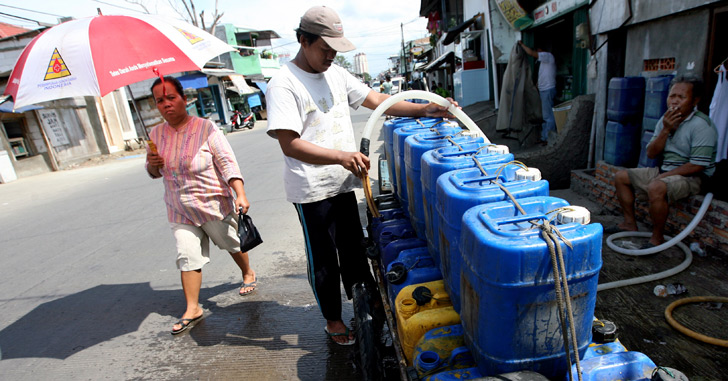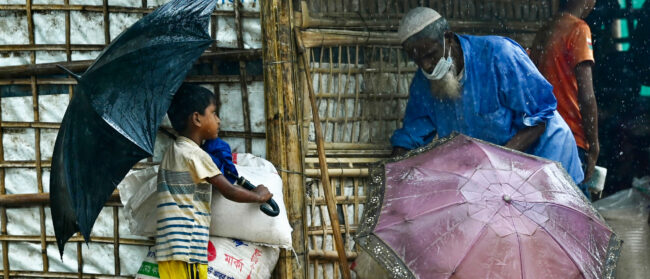According to a popular aphorism, Jakarta has ‘the most expensive dirty water in the world’. While not strictly true, it nevertheless reveals the disquiet of Jakartans, of whom only 59% have access to piped water sources, according to the 2015 book Our Public Water Future. Released by the Transnational Institute, an international advocacy organisation, the book adds that the piped water is mainly the preserve of those in wealthy neighbourhoods; the rest rely on bottled water or private wells.
The source of Jakartans’ pithy proverb can be traced back to the 1990s, when two European firms, Thames of the UK, and Suez of France, initiated negotiations with Indonesian officials to gain control of Jakarta’s water supply. At that time, the city’s waterworks were under the control of PAM Jaya, a publicly run utilities firm. Thames and Suez promised that if Jakarta’s water supplies were privatised, rates would be reduced, infrastructure improved and access expanded. It was a successful pitch and, in 1997, they exclusively carved up Jakarta’s water supply between themselves – Suez took the west of the city; Thames the east.
“[It] is a story of powerful multinationals that deftly used the World Bank and a compliant dictatorship to grab control of a major city’s waterworks.”
Andreas Harsono, journalist
In 2003, the Indonesian investigative journalist Andreas Harsono described the agreement thusly: “[It] is a story of powerful multinationals that deftly used the World Bank and a compliant dictatorship to grab control of a major city’s waterworks.” Thames and Suez had recruited family members and cronies of the then dictator, Suharto, to lobby on their behalf and to run the local subsidiaries, Harsono wrote, and secured favourable concessions “without public consultation or bidding”.
PAM Jaya was left as a toothless overseer. The foreign firms agreed to pay off its debts and, in return, it would “force businesses and private homes to shut down private wells and buy their water from the consortia”, Harsono wrote. This was at a time when 70% of water consumed by Jakartans came from private wells.
However, for more than a decade, a campaign was fought against this privatisation of the city’s water management. At the forefront was a group of Jakartans calling themselves the Coalition of Jakarta Residents Opposing Water Privatisation (KMMSAJ). On the afternoon of 24 March 2015, they thought they had finally secured a victory when the Central Jakarta District Court annulled the contracts of the two largest companies – the subsidiaries of Thames and Suez. The presiding judge in the case stated the companies had been “negligent in fulfilling the human right to water for Jakarta’s residents”.
“It is an important victory, both for impacted communities in Jakarta and for those around the world who have been calling on courts and decision-makers to recognise and take action against the human rights violations of multinationals seeking to make profits from essential services like water and sanitation,” Meera Karunananthan, an international water campaigner for the Blue Planet Project, told Southeast Asia Globe in February.
However, on 2 March 2016 the ruling was overturned by the Jakarta High Court following appeals by the government and the two private companies. Arief Maulana, a lawyer representing the KMMSAJ, told local media that the ruling’s reversal was because of technicalities in the lawsuit, not the issue itself, and vowed to continue fighting.
If the KMMSAJ is successful, then Jakarta will join a global trend. In the past decade, 235 cities across 37 countries have taken back their water services from private companies and delivered them to public entities, said Emanuele Lobina, a lecturer at the Public Services International Research Unit of the University of Greenwich, UK.
“The problems with water privatisation in Jakarta are similar to those with water privatisation across developed and developing countries,” said Lobina. “These are caused by conflicts between the private sector’s profit maximisation imperative and local development objectives, like sustainable development and the human right to water.”
The debate over water ownership is akin to debates over most essential services. Proponents of privatisation claim these services are in safer hands with businesses, which can provide greater levels of investment, increased access, streamlined operational costs and, subsequently, a cheaper product. Advocates for nationalisation call this a myth, claiming there is no sound evidence anywhere in the world for such improvements taking place and, instead, suggest that with water under the auspices of public bodies, it minimises the profit-driven motive and can operate for the common good.
In the 1980s, the UK became the first country in the world to completely privatise its water management services. In the decades that followed, cities and countries around the world followed suit. In 1997, for example, Manila was divided between Maynilad Water Services, a joint venture between Suez and a local conglomerate, and Manila Water Company, which consisted of a local firm along with United Utilities from the UK, Bechtel of the US and Mitsubishi from Japan.
However, according to opponents of water privatisation, it has rarely been a voluntary act. For many commentators, the organisations pulling the strings are the World Bank and the International Monetary Fund (IMF).
Heni Kurniasih, of the University of Melbourne, said there is ample evidence that the World Bank and IMF “required the Indonesian government to undertake water privatisation in order to receive loan packages”. In 1992, when the World Bank provided $92m to PAM Jaya to improve Jakarta’s water infrastructure, according to Kurniasih this came with the “suggestion” it open the way for private companies to participate, which was enacted five years later.
This has been dubbed ‘lending conditionality’ and the World Bank and IMF have used it to persuade governments across the world to privatise their water supplies, said Kurniasih. According to a 2015 article in the Guardian, the International Finance Corporation (IFC), the World Bank’s private arm, has loaned more than $75 billion for water and sanitation projects worldwide since 1995.
Many of the world’s largest multinational firms, most of which previously had no interest in water, saw that substantial profits could be made. The likes of Goldman Sachs, JP Morgan and Deutsche Bank invested heavily in water management projects across the world. “Water is the oil of the 21st century,” Andrew Liveris, CEO of the Dow Chemical Company, told the Economist. A 2013 report by Allianz Global Investors estimated that the global water market could be worth more than $1 trillion by 2020.
However, from a peak of 85 major water privatisation projects funded by the IFC in 2007, only 22 were recorded as starting in 2013. What’s more, 63 projects – 28% of the IFC’s total water investments over the past two decades – have failed or are in difficulty, World Bank statistics show. Its data also makes clear that 34% of all private water and sewerage contracts entered into between 2000 and 2010 have failed. This compares to 6% for energy projects and 3% for transportation.
Kurniasih suggests one explanation for these divergent failure rates is that water resources often cross boundaries of management. After all, waterways or lakes rarely fall under one jurisdiction or the ownership of one private company.
A solution to this problem, said Lobina, is public-public partnerships (PUPs), collaborations between several government bodies or national authorities. There are 137 PUPs in about 70 countries currently in operation in the water sector, he added, pointing to Phnom Penh as a good example.
“Water coverage increased from 20% in 1993 to 70% by 2004, and 90% by 2007, thanks to in-house restructuring and the successive adoption of PUPs between the local public water operator, the Phnom Penh Water Supply Authority, and a number of public water operators from the ‘global North’,” Lobina said.
One of the first groups to establish PUPs was the Yokohama Waterworks Bureau (YWB) from Japan, which has helped to train staff from other Asian countries since the 1980s. In 2003, the YWB began assistance projects with public water operators in Vietnam’s Ho Chi Minh City and Hue. Four years later, it entered a formal PUP with the Thua Thien Water Supply and Construction State Company (COWASU).
“In 2008, COWASU became able to provide safe drinking water to 95,000 users in the city of Hue one year ahead of schedule. This is a first in Vietnam,” reads a report by the Transnational Institute.
However, according to Kurniasih, the precipitation of either public- or privately owned water management also comes down to the relative strengths of governments and civil societies.
“Privatisation can only occur if the local government is strong [enough] to push the [privatisation] agenda [and] civil society has insufficient power to oppose [it],” she posited. “It’s possible that the trend of re-municipalisation reflects the increasing power of non-state actors that have been able to voice their concern over the failure of water privatisation to fulfil the basic human rights on safe water.”
In the future, she added, the debate about water rights will become more urgent. All Southeast Asian countries, she said, share similarities: water scarcity; poverty that divides the formal and informal water supply network; and issues with governance.
The UN’s latest World Water Development Report warns that 40% of the world’s population will be without access to water by 2030, while in 2012 Forbes predicted that “water could emerge as a potential source of conflict” in Asia as countries compete for ownership of this finite resource.
“One important lesson emerging from Jakarta and Phnom Penh,” said Lobina, “is that a sustainable future for water supplies in regions such as Southeast Asia lies in avoiding or rejecting privatisation and embracing in-house restructuring and PUPs.”


